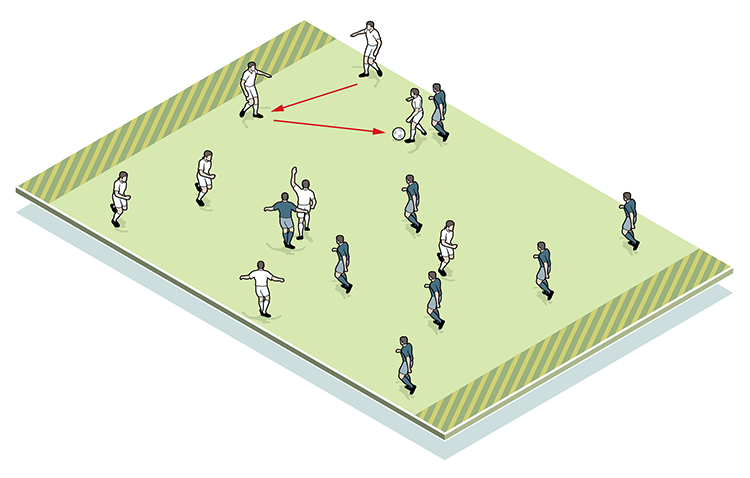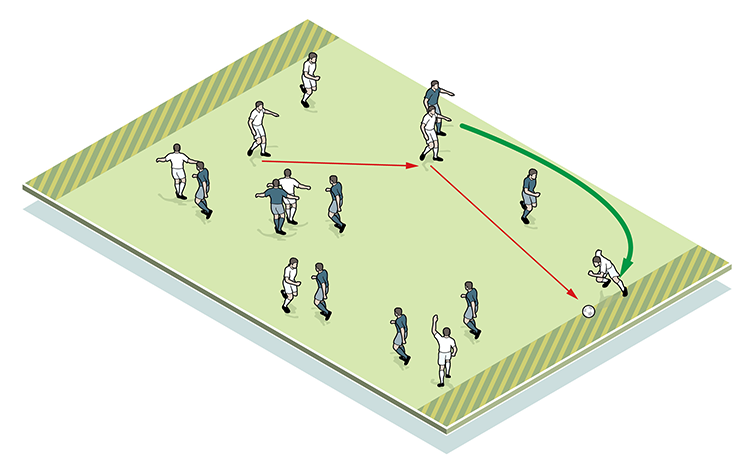You are viewing 1 of your 1 free articles
Running without the ball
We will practice this session at least once a fortnight. Running in behind without the ball is extremely valuable because it steers players into dangerous areas of the pitch. Constantly offering different threats to the opposition defence is important, but this move also helps us retain possession, which is vital.
| Area | 75x40 yard playing area, 5 yard scoring zones at each end |
| Equipment | Balls, cones |
| No. of Players | 16 (two teams of 8) |
We will practice this session at least once a fortnight. Running in behind without the ball is extremely valuable because it steers players into dangerous areas of the pitch. Constantly offering different threats to the opposition defence is important, but this move also helps us retain possession, which is vital.
This set-up has already paid dividends for us this season. In our away league game at Leyton Orient we had been reduced to 10 men and were being held 1-1 with half-an-hour left.
We had to soak up pressure and break forward at pace. Our second goal on the night came from a great run in behind by Lee Martin, who picked out Scott Wagstaff to score. Wagstaff then turned provider for Chris Solly in the final minute as we emerged 3-1 winners.
What do I get the players to do?
Each team of 8 players attacks an end zone. A point is scored when a player makes a run into the zone and receives a pass. That is the only time attackers can enter that area - they cannot stand there waiting for a pass. The same applies for defenders , who must remain outside until they are tracking a run.
We always insist on playing at high intensity because as well as being good for positioning and tactical play, it’s great for improving and maintaining fitness levels. Players can only score by making a run, so that encourages good and plentiful movement.
What are the key things to look out for technically/tactically?
For attackers, quality of passing is essential. We have some very good footballers at Charlton Athletic, but you can never over-practice passing the ball, and this move tests accuracy and weight of pass in a pressured situation. Individually, players need to show they can make intelligent and well-timed runs, and instinctive decision-making is also key.
For defenders, the job is to approach and tackle, whilst always being aware of opposition runs in an around them. Mostly, these runs will come on the wings, but they also need to be aware of breaks through the middle.
1

2

3

How do I progress the session?
We progress the session by reducing the size of the scoring zone at each end to 4 yards, then 3 yards. This creates the need for increased accuracy and timing.
Award a point if a team manages eight consecutive passes. This will focus the attacking team, whilst forcing defenders to press their opponents knowing that they cannot sit deep. Additional space is created in behind which helps to naturally advance the session further.
4

5

6

How would you put this into a game situation?
Use the full length of the pitch with a scoring zone at each end. Play 10v10, always looking for the runs coming in from behind.
Related Files
Editor's Picks
Intensive boxes drill with goals
Penetrating the final third
Creating and finishing
My philosophy
Pressing initiation
Compact team movement
Defensive organisation
Back three tactics
Counter-pressing as an offensive weapon
Coaches' Testimonials

Alan Pardew

Arsène Wenger

Brendan Rodgers

Carlos Carvalhal

José Mourinho

Jürgen Klopp

Pep Guardiola

Roy Hodgson

Sir Alex Ferguson

Steven Gerrard
Coaches' Testimonials

Gerald Kearney, Downtown Las Vegas Soccer Club

Paul Butler, Florida, USA

Rick Shields, Springboro, USA

Tony Green, Pierrefonds Titans, Quebec, Canada
Join the world's leading coaches and managers and discover for yourself one of the best kept secrets in coaching. No other training tool on the planet is written or read by the calibre of names you’ll find in Elite Soccer.
In a recent survey 92% of subscribers said Elite Soccer makes them more confident, 89% said it makes them a more effective coach and 91% said it makes them more inspired.
Get Monthly Inspiration
All the latest techniques and approaches
Since 2010 Elite Soccer has given subscribers exclusive insight into the training ground practices of the world’s best coaches. Published in partnership with the League Managers Association we have unparalleled access to the leading lights in the English leagues, as well as a host of international managers.
Elite Soccer exclusively features sessions written by the coaches themselves. There are no observed sessions and no sessions “in the style of”, just first-hand advice delivered direct to you from the coach.








